An early cemetery was located on the Samuel Kennedy homestead on SW 29-6-4w, near where the Missouri Trail crossed the Boyne River. The first recorded burials were in 1875 when two of the Kennedy children died. In the same year, Mrs. John McCullough and her daughter, Mary, were buried there after succumbing to typhoid fever. Names of other families who used the cemetery were: Stewart, Olson and Moyle.
The last burial at the site was in 1889. In later years, grave markers began to crumble into the river. The markers were retrieved, stored in the Carman Granite workshop for some years and finally placed in Greenwood Cemetery on the Kennedy grave.
2023-The making of a project. Our committee had one major project lined up for the summer months – placing a memorial monument at the long-abandoned Kennedy Burial Site east of Carman. This is one of four known sites where early, post-1870 settlers were buried before ‘official’ cemeteries were established in the Carman/Dufferin area.
Kennedy Burial Site. In 1875, four people in the Boyne Settlement died from typhoid fever and were buried on the Samuel Kennedy homestead, close to where the Missouri Trail crossed the river. Between 1875 and 1889, at least ten people were buried at this location. Some thirty years later, a new landowner removed the grave markers from the site. Three of the gravestones were later retrieved and placed on the Kennedy plot in Greenwood Cemetery. The site itself has remained unmarked.
In the early days of settlement, before the establishment of official cemeteries, people who died from accidents, disease or old age were buried in local burial sites. We identified five of these now-abandoned sites in the Carman/Dufferin municipalities. [link to Cemetery guidebook on website]. The burial ground for which we have the most information is the Kennedy Burial Site.
If everything had gone according to plan, this update would be featuring photos and a description of the unveiling ceremony. But we all know Robert Burns’ observation from that “The best laid schemes of Mice and Men/Gang aft agley…” Or as Murphy’s Law puts it, “If anything can go wrong, it will.” So, instead of documenting an unveiling with photos and the wise words of dignitaries, we’re going to look instead at what went on behind the scenes.
Kennedy Burial Site project. In 1875, a typhoid epidemic took the lives of four members of the fledgling Boyne Settlement. They were all related to Samuel Kennedy, the first white settler in the area, and were buried on the Kennedy homestead (29-6-4w) one and a half miles east of the present-day Town of Carman. Over the next few years, at least ten people were buried at the site. In later years, grave markers were removed from the plots and all traces of the burials vanished. How, then, could we locate the graves?
An early photo showed the Kennedy homestead, but it provided no further clues to the location of the burial site. Local histories placed it just west of the point where the Missouri Trail crossed the river. Dowsing provided further evidence of burials in this area.
But who was buried there? Thanks to the persistent efforts of an earlier Kennedy descendant, we had a significant amount information about the burial site and its occupants.
The names of the people buried at the site might also have been lost were it not for the work of Margaret Glanfield, a descendent of the Kennedy family. Through correspondence with local contacts and letters to the newspaper, she drew attention to the site and provided information about the people buried there. Now, a couple of generations later, three more Kennedy descendants – Nikki Falk (whose great-grandmother and her daughter were the first burials at the site), Linda Baleja and Rhonda Davidson – are working with C/D MHAC to ensure their ancestors and others buried there are not forgotten.
Margaret Glanfield’s quest. Margaret Viola (Kennedy) Glanfield (1917- 2006) was a descendant of the first Kennedy settlers. She was incensed by the fact that a later landowner had removed gravestones from the site. To add insult to injury, when the Kennedys took the owner to court for perceived desecration of a cemetery, they lost the case. Over the years, Margaret corresponded with local residents and compiled a list of burials, dates and relationships. She also sent the list to the Carman newspaper. When she learned that at least three gravestones had been retrieved rom the riverbank and stored in the Billings monument workshop, Margaret arranged to have these markers placed on the Kennedy plot in Greenwood Cemetery.
CD MHAC were fortunate to have another Kennedy descendant on our committee in the person of Nikki Falk. Her great-great-grandmother, Margaret McCullough, was Samuel Kennedy’s sister-in-law. She was said to have been the first person buried at the site. Nikki had already collected copies of the Glandfield materials, as well as these photos from the Kennedy family collection.
She enlisted the help of two of her cousins to work on the project. With a determination that would do their ancestors proud, the group took up Margaret Glanfield’s earlier quest. Using online sources that hadn’t been available in earlier days, they were able to confirm or correct our source material. They also discovered valuable new information. For the first time, for example, we learned more about the background of the Kennedys’ neighbours, the Ryer Olsen family. Their child may be the only non-Kennedy buried in the site.
Marking the Site
Meanwhile, other committee members met with the landowners to ensure they were fully on board with our plans. Together, we decided on a natural rock memorial, on a gravel base, placed near a maple tree where it would blend in with the landscape. C/D MHAC stalwart, Edwin Pritchard, cleared the area of new growth. The site was ready to receive the rock.
The search for a suitable granite rock took the team on a rock-hunting venture to the west escarpment where rocks and gravel are mined from huge open gravel pits.
The escarpment was once the bank of Lake Agassiz, formed in the post-Ice Age when glaciers melted. They left behind the lake that once covered most of Southern Manitoba along with huge boulders and gravel deposits that form part of the escarpment. It is a graphic reminder of how little of our heritage is represented in our post-1870 written accounts, compared with oral and natural histories of the area.
The rock-hunt was a success. The sub-committee also assembled an informative packet of research and located new information about the people buried at the site. Their names are being permanently recorded on the bronze plaque that will be affixed to the rock to ensure they are remembered by generations to come. Our challenge now is to get the rock on a foundation and the plaque on the rock, all before the planned unveiling this autumn.
At this point, a neighbour from the adjoining property had a welcome surprise for us – a piece of one of the early gravestones family members had located years ago on the riverbank. The marker had previously been repaired. Parts of two words can be see. There is no way of telling which grave it was from.
At this point, we confidently set a deadline for unveiling the memorial. It would be done before mid-September so we could include a surprise guest who would be visiting from Ontario. What could go wrong?
The team set off to locate a suitable large rock. After a number of queries, we headed to the escarpment to spend a sunny afternoon examining dozens of rocks in the huge Collet Gravel quarries.
Having made a selection, the next issue was how to get it to the site? The gravel company generously offered to donate the rock to our committee with just a small loading fee. Nikki arranged for her husband, Bob, to transport the two-ton rock to the site with his truck and trailer. A friend with a forklift was recruited to help unload and place the rock at the site. Everything was clicking into place.
Meanwhile, the team had been busy arranging for the memorial plaque. It would be bronze, in keeping with other C/D MHAC heritage signs, with names and details of everyone known to have been buried at the site. This activity interfaced with ongoing research. We edited, exchanged rounds of emails, edited some more. Our long-time colleagues at Checkers Signs drew up drafts with our editorial changes.
Placing the Marker
Having made a selection, the next issue was how to get it to the site? The gravel company generously offered to donate the rock to our committee with just a small loading fee. Nikki arranged for her husband, Bob, to transport the two-ton rock to the site with his truck and trailer. A friend with a forklift was recruited to help unload and place the rock at the site. Everything was clicking into place.
Memorial Plaque
Meanwhile, the team had been busy arranging for the memorial plaque. It would be bronze, in keeping with other C/D MHAC heritage signs, with names and details of everyone known to have been buried at the site. This activity interfaced with ongoing research. We edited, exchanged rounds of emails, edited some more. Our long-time colleagues at Checkers Signs drew up drafts with our editorial changes.
Then, after we had submitted our final draft, someone discovered an error in a date on the plaque, one that four pairs of eyes had missed. Checkers Signs came through like champions with a replica that could be used to ensure we met our deadline for the unveiling ceremony.
Then it rained. Given the muddy mess heavy machinery would make at the site, we reluctantly agreed to postpone moving the rock. This was hugely disappointing, since our out-of-province guest would be leaving shortly. Common sense prevailed and the unveiling ceremony was postponed. A week or so later, the move was made successfully and as originally planned.
By now, Murphy’s Law was becoming bit of a nuisance. Like most people, we figured this was an ancient bit of wisdom rooted in the depths of the Celtic lore. No wonder the law asserted itself at the place where Irishman Samuel Kennedy, an ardent member of the Orange Lodge, had renamed the local Îlets-de-Bois River after the Battle of the Boyne.
As so often happens, an online check suggested a very different origin. The general concept behind the rule has been around in some form or other for a long time. However, the name “Murphy’s Law‘ and the current statement of the rule are attributed to an aeronautical engineer, United States Air Force Captain Edward A. Murphy, who stated it circa 1950 with regard to devices they were testing. The point he was making was that errors and malfunctions are a reality of any undertaking. To avoid problems, you need to anticipate and plan for all possible mishaps. It was intended as a call to excel rather than a message of hopelessness and gloom. From that perspective, if we had barged ahead to meet our deadline, no matter what, the official unveiling of Kennedy Burial Site project could well have taken place in a field of mud, with an incorrect date on the plaque.
Acknowledgements. The most heart-arming aspect of this review of the project is the fact that it reminds us of the large number of people and organizations who donate hours of their time, along with their expertise and resources, towards making our heritage projects happen. It is with that recognition that C/D MHAC extends a sincere “Thank you” to the following people/businesses whose donations and volunteer assistance helped us make the Kennedy Burial Site project a reality: landowners Vince Southern & Judy Duthie; Collet Gravel, Notre Dame de Lourdes; Checkers Signs, Morden; sub-committee members Linda Baleja & Rhonda Davidson; Bob Falk & Norbert Major; Alice & Gerry Vandersluis; Trish Glanfield and other Kennedy family contributors.
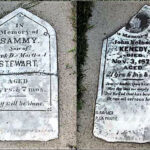 June 2023
June 2023
Our C/D MHAC sub-committee is working towards placing a monument at the former Kennedy Burial Site to commemorate the individuals buried there back in the late 1870s. Sub-committee Chair Nikki Falk’s great-great-grandmother and other relatives were among the early settlers who died during a typhoid outbreak. They were buried near the Missouri trail on land then owned by Samuel Kennedy, the first settler to take up a post-1870 land grant in the area. A recent meeting with the current landowners was most encouraging and we’re looking forward to seeing exciting results from the sub-committee this summer.
Two damaged grave markers retrieved from the Kennedy Burial Site

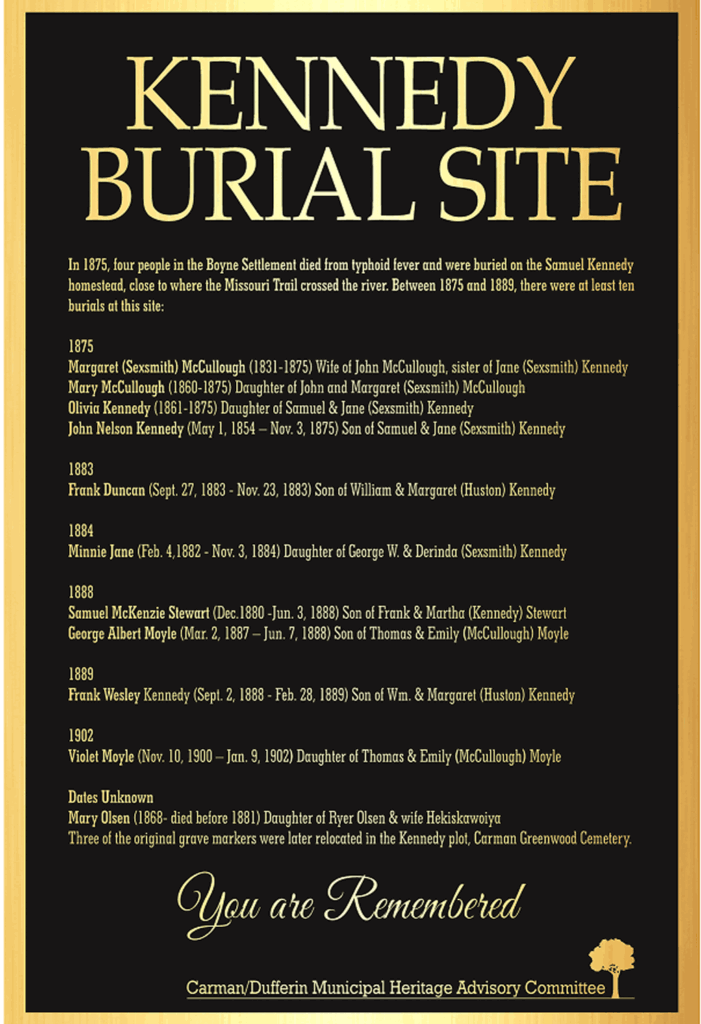
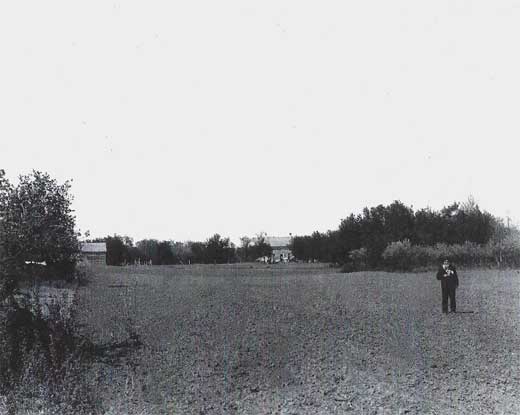
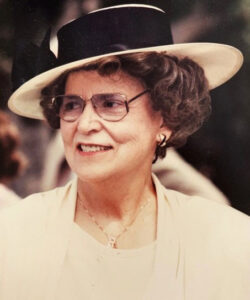

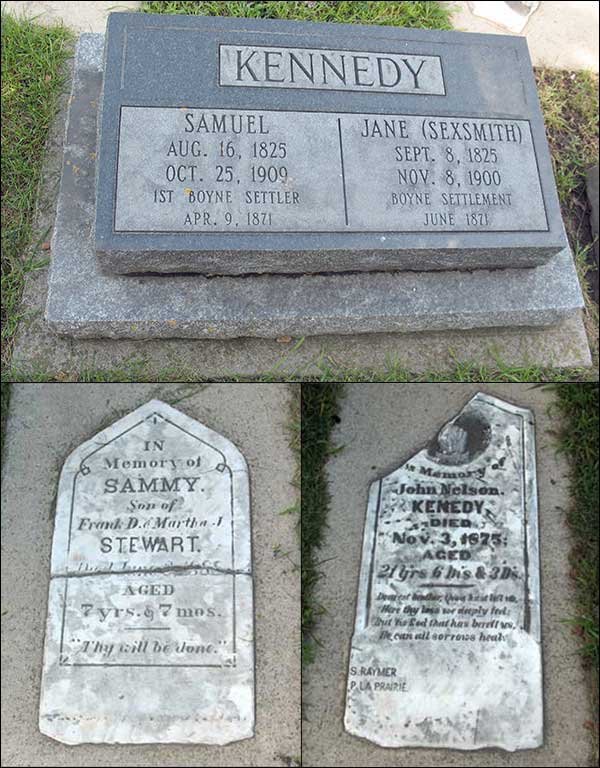
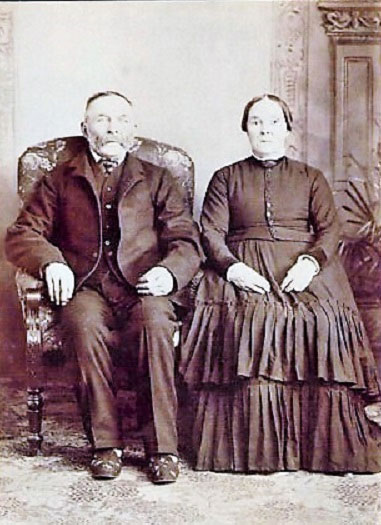
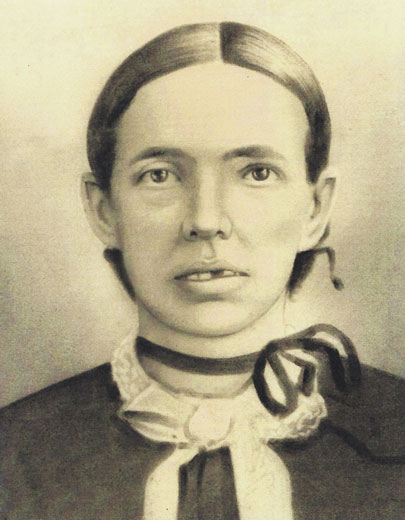
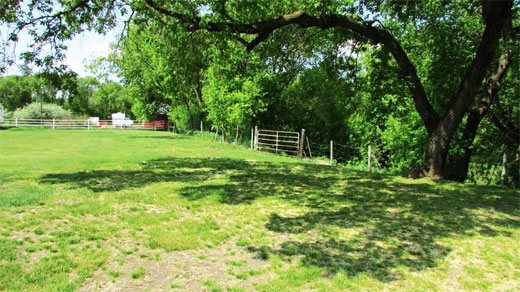
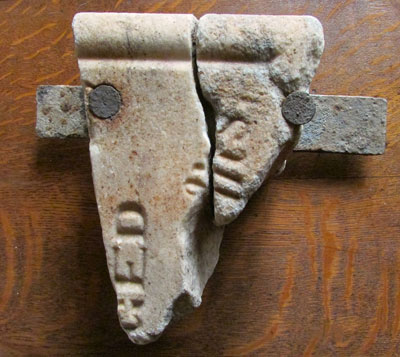
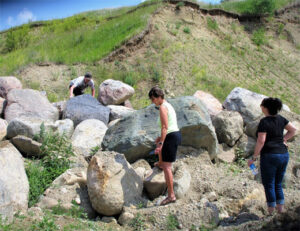
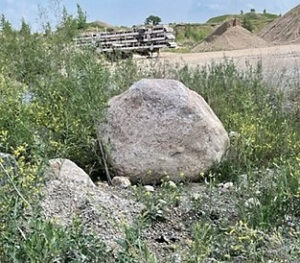
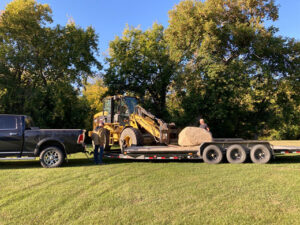
![[Photo credit: N. Falk] Rock in place awaiting the plaque](https://carmandufferinheritage.ca/wp-content/uploads/2024/11/Rock-placement-8-300x225.jpg)